On this page
Books about feathers, moult and related topicsThe books are listed by publication date with the most recent at the top.
|
|
|
|
Feathers of European Owls: Insights into Species Ecology and IdentificationMarian Cieslak
Oriolus Forläg
2017
"Feathers of European Owls fills many gaps in current knowledge of owl feathers. The author not only describes the identification of feathers of the European owl species, but also presents relationships between feather morphology and the behaviour and ecology of this group of birds. These findings are largely based on the Author's original research, and his extensive collection of feathers.
|
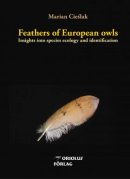 |
|
Feathers: Displays of Brilliant PlumageRobert Clark
Chronicle Books
2016
"These beautiful photographs from award-winning National Geographic photographer Robert Clark offer a fascinating new view of bird feathers. Each detailed close-up image is paired with informative text about the function and evolution of that feather, making this handsome volume the perfect marriage of art and science."
|
Buy from amazon.co.uk 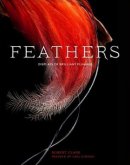
|
|
Bird Feather SciencePravin N. Charde and Rucha S. Karanjekar
Biotech Books
2013
|
Buy from amazon.co.uk 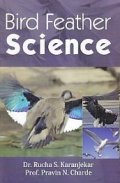
|
|
Feathers: The Evolution of a Natural MiracleThor Hanson
Basic Books
2011
"This is the untold natural and cultural history of nature's finest invention. Feathers are quite an evolutionary marvel: aerodynamic, insulating, beguiling. Their story begins in the Jurassic and leads through the development of flight to high fashion. Yet, their story has never been fully told. In "Feathers", biologist Thor Hanson tells a sweeping natural history of feathers, as they've been used to fly, protect, attract, and adorn through time and place. Applying the research of paleontologists, ornithologists, biologists, engineers, and even art historians, Hanson asks: What are feathers? How did they evolve? What do they mean to us?"
|
Buy from amazon.co.uk 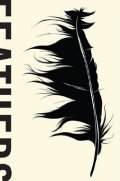
|
|
Bird Feathers: A Guide to North American SpeciesS. David Scott and Casey McFarland
Stackpole Books
2010
"This guide teaches birders to use the characteristics of wing types and feather morphology to identify feathers - not only by species but also by their place on the bird's body. The introductory chapters give a detailed overview of the feather - how feathers developed, the parts of a single feather, and the variety of types of feathers on a bird. In the feather identification section, more than 400 color photographs show feather samples from 379 bird species from all over North America. Along with the wing type of the species and a map showing its range, several types of feathers are included for each bird; each feather is labeled with its type and its size."
|
Buy from amazon.co.uk 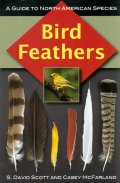
|
|
Ptilochronology: Feather Time and the Biology of BirdsThomas C. Grubb
Oxford University Press
2006
"This is the first book to summarize the methods, conceptual issues and results of studies using the interpretation of feather growth rates as an index of nutritional condition in birds. The author has coined the term ptilochronology (literally, 'the study of feather time') to describe this technique, which relies on the fact that as a feather grows it produces visible growth bars. Both the technique and its conceptual foundations have been applied worldwide to numerous studies of avian evolution, ecology, and conservation biology. The author reviews this work, chronicles the various criticisms that have been made, and describes how these have influenced the development of ptilochronology. He goes on to suggest experimental methodologies and analytical techniques to safeguard against invalid results. A final chapter summarises this new technique's contribution to avian biology, and suggests potential applications and a future research agenda. An appendix details specific measurements and describes the methodology associated with ptilochronology." Contents: Preface; Part I. Basic Ptilochronology; Introduction; Can Reduced Nutritional Condition Really Cause Narrowed Growth Bars?; Does Any Factor Other Than Nutritional Condition Control Feather Growth?; Part II. Applied Ptilochronology; Habitat Quality; Nutritional Consequences of Self-cached Food; Social Behavior; Individual Quality; Reproductive Effort; Nestling Condition; Prolonged Brood-Care; Taking Stock and Looking Ahead; References; Appendix.
|
Buy from amazon.co.uk 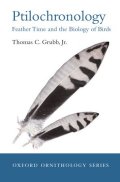
|
|
Moult and Ageing of European Passerines: A Photographic GuideL. Jenni and R. Winkler
Poyser
1994
"The moult strategies of birds are not only of importance in their impact on a species' ecology and energetics but as a valuable tool for anyone studying the migration and population dynamics of bird species. A proper understanding of how feathers are replaced, and the precise differences in appearance of the various feather generations, can allow ringers, scientists and the keen birdwatcher to age first-year and adult birds and to detect the moult strategy of the bird in question. Lukas Jenni and Raffael Winkler have combined these themes and produced a book which will be valuable both to the professional ornithologist and the bird ringer. The first part gives an up to date summary of the moult strategies and moult sequences of European pesserines and discusses the ecological consequences of moult. Throughout the book, the authors draw on the enormous amount of data on moult collected by them over 15 years of study which, combined with data from the literature, allow them to present a new synthesis of the subject. The second part of the book is of value to ringers. Following a general introduction to ageing, detailed moult profiles are given for 50 species of European passerines representing all the major moult strategies, backed up with useful summary statistics, schematic diagrams of the extent of moult and indications of the variation within each species. For the first time, the extent of partial and suspended moults is presented in detail. This book features over 480 colour photographs of extended wings which show the entire range of moult patterns and of plumage ageing criteria. An appendix gives supplementary information on ageing birds by the degree of pneumatization of the skull. This book is both a major reference for ornithologists, zoologists, bird ringers and dedicated birdwatchers, and a work of great scholarship and beauty."
|
Buy from amazon.co.uk 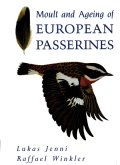
|
|
Moult in BirdsH.B. Ginn and D.S. Melville
BTO Guides 19
British Trust for Ornithology
1983
"This work falls into two parts. The first section gives a short general summary of the plumage of birds, its structure, arrangement and functions and briefly reviews the various types of moult patterns which are found and the ways of recording them. The second part gives a systematic species-by-species account of points including the number of flight feathers, the sequence, season and rate of moult, its relationship to breeding and migration, and the extent of the post-juvenile moult."
|
Buy from amazon.co.uk 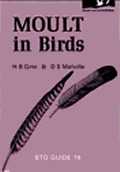
|
|
A Guide To Moult In British BirdsDavid Snow
British Trust for Ornithology
1967
|
Buy from amazon.co.uk 
|
|
The Photographic Analysis Of A FeatherJohn S; Gladstone
Henry Southeran & Co
1918
From the introduction: "AT the suggestion of my cousin, H. S. Gladstone, a keen Ornithologist, I took up the examination of Feather Construction. He pointed out to me that up to date the illustrations in ornithological works were hand drawings and that a set of photographs would be of some value. My cousin very kindly obtained for me from the Zoological Gardens, Regent's Park, a collection of feathers ranging from the Golden Eagle to the diminutive Parrakeet. In addition to these the shooting season provided feathers of British Game Birds, so I was able to examine specimens of practically all the orders of British Birds. After a lengthy study with the microscope the conclusion arrived at was that the construction of a feather is the same, whether it belongs to a Golden Eagle or a Sparrow. It was clear therefore that all that was necessary was to record typical species."
|
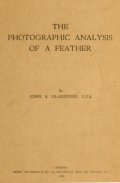
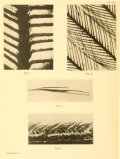 |
|
A Study Of The Structure Of Feathers, With Reference To Their Taxonomic SignificanceAsa C. Chandler
University Of California Press
1916
From the introduction: "Although as a class birds have received more attention from nearly all classes of zoologists than any other group of vertebrate animals, their natural classification presents a great many problems difficult of solution, and no satisfactory phylogenetic arrangement has yet been devised for them. It was with the hope of throwing light on some of the dark places in the taxonomy of birds that the writer attempted the work, the results of which are presented in this paper, since it was believed that the comparative morphology of feathers would almost certainly be of some taxonomic value in establishing the relationships of various groups of birds. Since feathers are external and in constant contact with the environment, they would naturally be expected to be among the first structures of the body to feel the influence of environmental changes and shocks, and would still be as liable to change by hybridization, orthogenesis or any other method of evolution, as any of the other structures."
|
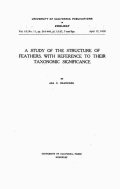
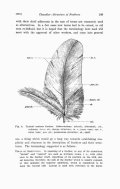 |
|